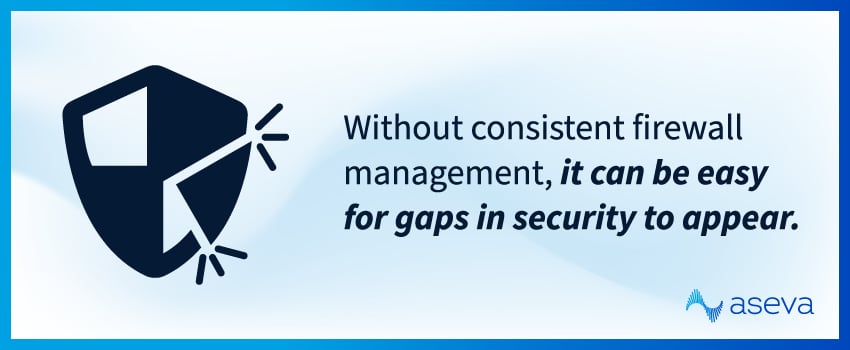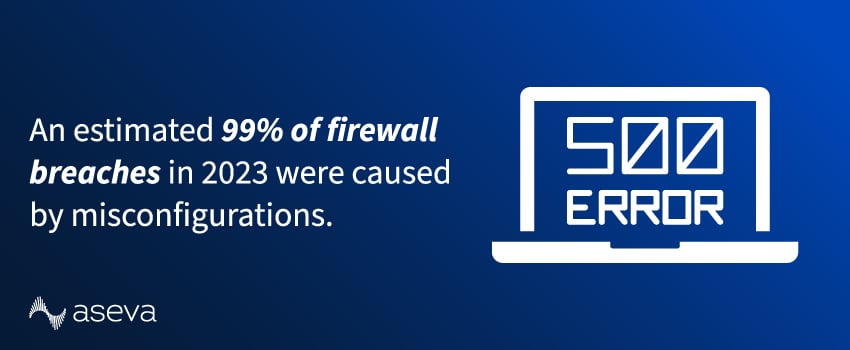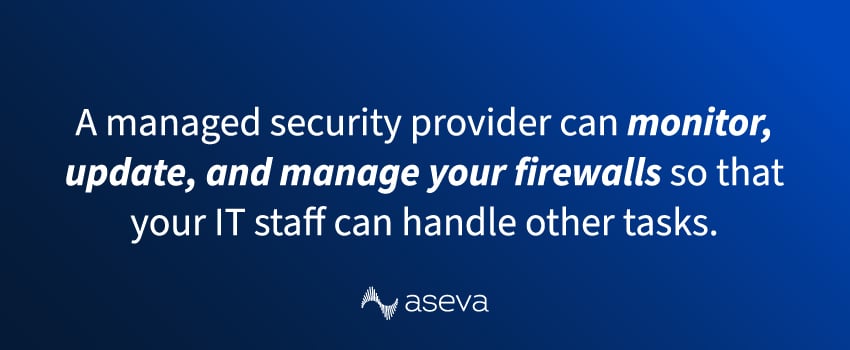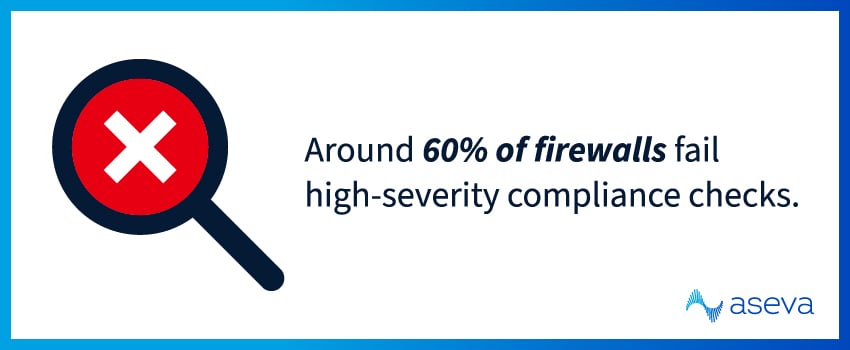Cybersecurity can feel like a never-ending task, especially when threats keep evolving. But strong firewall management is what helps ensure that your security tools are actually doing their job – protecting data, supporting compliance, and keeping business running.
Businesses have seen weekly cybersecurity attacks grow by 58% over the past two years,1 and firewalls are often the first line of defense. Without the right management strategy in place, even the most advanced firewalls can leave gaps that attackers are ready to exploit.
At Aseva, we help businesses implement and maintain firewall management solutions that streamline security strategies. Read on to explore the different ways to approach firewall management and best practices to help you stay ahead of threats without overcomplicating your infrastructure.
What Is Firewall Management?
Firewall management is the process of configuring and maintaining firewalls to effectively protect your IT environment. This typically involves:
- Defining and enforcing access rules
- Updating firewall software and firmware
- Monitoring logs and alerts for threats
- Ensuring policies meet compliance standards
Without consistent firewall security management, it can be easy for gaps to appear. Rules become outdated, access permissions grow too broad, or policies fall out of sync with business needs. All of that creates risks that can lead to issues like downtime or breaches.

Firewall Policy Management
Firewall policies define who and what can access your network – and under what conditions. Clear, well-managed policies reduce confusion and help keep your IT environment secure.
Best practices include regularly reviewing your existing firewall policies, documenting each change, and applying the principle of least privilege. This means giving users or systems only the access they truly need, and nothing more.
Firewall Rule Management
Firewall rules are what actually enforce your security policies. They determine how traffic flows in and out of your network, and whether it gets blocked or allowed.
Rule sets can become cluttered over time. A new service gets added, a user leaves, or a quick fix turns into a permanent exception. These small changes add up and can make your firewall harder to manage.
That’s why it’s important to regularly clean up rules, use clear naming conventions, and prioritize the rules that support your mission-critical traffic.
Why Does Firewall Management Matter?
Firewall management plays a major role in your overall security posture. If you’re not actively maintaining your firewall, there’s a good chance it’s not doing its job. A properly managed firewall offers advantages like:
Reduced Risk of Misconfigurations
Improper configurations are one of the top causes of network breaches, with Gartner estimating that 99% of firewall breaches in 2023 were due to misconfigurations.2 Even a small error in a rule or access control setting can expose your entire environment to threats.

Adapt to Modern Threats
As security threats evolve, your firewall needs to evolve too. Attackers are always finding new vulnerabilities in traditional defenses, so it's important to stay on top of firmware updates, vendor patches, and rule optimizations.
Meet Compliance Requirements
Industries subject to data privacy regulations like HIPAA, PCI DSS, or GDPR are required to maintain strong access controls and logging, both of which fall under firewall management. Auditors will often review firewall management policies to verify compliance, and around 60% of firewalls fail these high-severity compliance checks.3
Types of Firewall Management
Different organizations require different approaches to firewall management depending on their IT environment, team resources, and security posture. Some of the most common models are:
Cloud Firewall Management
Cloud-based firewall management offers flexibility and central oversight for workloads moving off-site. It’s especially useful for hybrid or multi-cloud environments where consistent policy and rule management across multiple systems matters. Policies can be applied across every cloud platform and adjusted as your needs change.
Managed Firewall Services
If you’re looking for a hands-off approach, working with a managed services provider may be the best fit. Aseva’s team of vendor-neutral technology advisors can help you find a managed security provider that monitors, updates, and manages your firewalls so that your IT staff can handle other tasks.
On-Premises Firewall Management
With on-premises firewalls, your team is responsible for managing all hardware and software. This option gives you full control but requires more time and expertise than cloud or managed versions.

Firewall Management Tools
The right firewall management tool can simplify oversight by centralizing policy, rule, and event data. They’re especially helpful when you’re juggling multiple firewalls or locations.
Look for tools that include:
- A centralized dashboard to manage policies and rules
- Automated alerts for unauthorized changes or suspicious activity
- Visual tools for analyzing traffic paths or rule overlaps
- Integration with SIEM or SOC platforms for broader visibility
Aseva can help you select and implement the best firewall management tools for your specific business needs – and ensure they’re configured to meet your security and compliance goals.
5 Best Practices for Firewall Management
Following a few best practices can make your firewall management smoother and more effective. These are the strategies we recommend to clients looking to improve their cybersecurity posture without adding unnecessary complexity:
1. Automate Where Possible
Automation tools can streamline repetitive firewall management tasks like software updates, rule validation, and monitoring. This reduces the risk of human error and threats slipping through the cracks.
2. Monitor Continuously
Firewall logs offer valuable insights, but only if someone is looking at them. Review any alerts in a timely manner, either by your team or with support from a managed security provider.
3. Document Everything
Keep clear records of all policy changes, rule updates, and configuration settings you make to your firewalls. Documentation helps during compliance audits and makes it easier to onboard new IT team members.

4. Regularly Review Rules
Set time on the calendar to clean up any outdated, redundant, or overly broad rules. We recommend doing this at least twice a year to keep your firewalls effective.
5. Plan for Growth
As your business grows, so does your network. Make sure your firewall management plan includes capacity considerations, including adding new locations, devices, or services.
Firewall Security Management in Hybrid Environments
Managing firewalls can be more complex if your IT infrastructure includes on-prem systems, cloud apps, and remote users. You may even be using different types of firewalls across multiple environments, each with its own configuration tools and policy frameworks.
Without centralized oversight, this patchwork approach can lead to inconsistent rules and visibility gaps.
Aseva’s cybersecurity experts bring it all together. We’ll help you find a managed firewall solution that unifies policy enforcement, centralizes monitoring, and pushes updates across cloud and on-prem systems so that your firewalls always work together, no matter where they’re deployed.
Take Control of Your Firewall Security Management With Aseva
Firewall management helps keep your systems protected, your policies consistent, and your teams focused. With the right approach, it becomes a reliable part of your broader security strategy – not a recurring headache.
At Aseva, we make it easy to find and implement best-fit security solutions that meet your unique needs. Our hands-on approach ensures you get the right tools, support, and peace of mind to keep your operations secure and your business agile.
Let our cybersecurity experts take the stress out of firewall management. Get started with Aseva today.
Sources:


